8 Herbal Teas For Upper Abdominal Pain
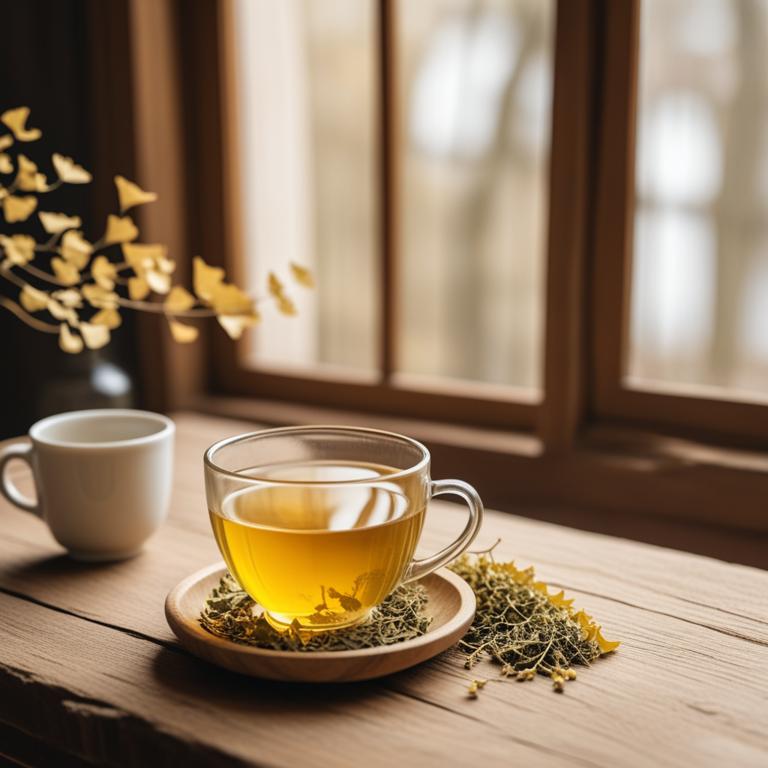
If you're experiencing upper abdominal pain, you might want to try drinking herbal teas.
These teas can help soothe your stomach and alleviate the discomfort. So, what makes them work?. Well, many herbs have anti-inflammatory properties, which means they can reduce swelling and pain in the digestive tract. Others have natural antacids that help neutralize stomach acid and calm down heartburn. For example, ginger (Zingiber officinale) tea has been shown to have anti-inflammatory compounds that can ease nausea and stomach discomfort.
Licorice root (Glycyrrhiza glabra) tea, on the other hand, has antacid properties that can help neutralize stomach acid and reduce inflammation in the digestive tract. Turmeric (Curcuma longa) tea has powerful anti-inflammatory compounds called curcuminoids that can reduce pain and inflammation in the stomach. Drinking herbal teas can bring many benefits to your life. For one, they're a natural and non-invasive way to manage stomach pain, so you don't have to rely on over-the-counter medications. They're also often caffeine-free and can be enjoyed by people of all ages. Plus, many of these herbs have additional health benefits, such as reducing stress and improving digestion.
So, if you're experiencing upper abdominal pain, give herbal teas a try and see if they can help you feel better.
- 1. Zingiber officinale
- 2. Glycyrrhiza glabra
- 3. Curcuma longa
- 4. Foeniculum vulgare
- 5. Cinnamomum verum
- 6. Mentha x piperita
- 7. Cinchona officinalis
- 8. Ginkgo biloba
1. Zingiber officinale
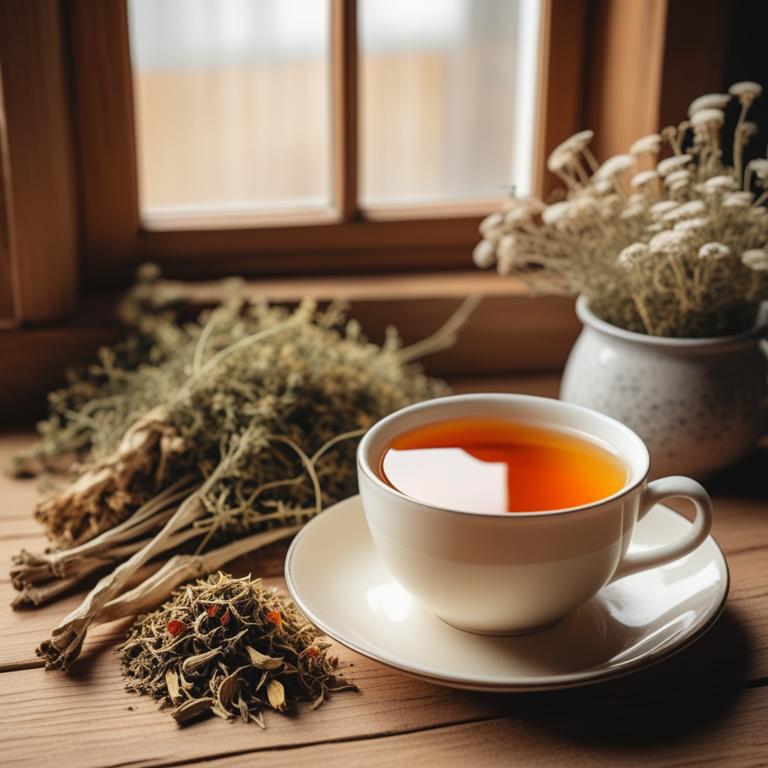
Zingiber officinale teas contains a compound called gingerol, which is responsible for its medicinal properties.
Gingerol has anti-inflammatory properties, which help reduce swelling and ease pain in the upper abdomen. The compound also has analgesic and antispasmodic properties, which help relieve cramps and spasms that can cause upper abdominal pain. Additionally, gingerol helps reduce inflammation in the digestive tract, which can help alleviate symptoms of conditions such as gastritis and ulcers.
The warm and soothing properties of Zingiber officinale teas also help calm the stomach and promote digestion, further relieving upper abdominal pain.
- Gather 1 tablespoon of dried Zingiber officinale root and 1 cup of boiling water.
- Place the dried root in a tea infuser or a small strainer.
- Steep the root in the boiling water for 5-7 minutes.
- Strain the tea into a cup and discard the root.
- Drink the tea 1-2 times a day as needed for relief from upper abdominal pain.
Zingiber Officinale Tea on Amazon
FGO Organic Ginger Tea, 100 Count, Eco-Conscious Tea Bags, Caffeine Free, Packaging May Vary (Pack of 1)
Disclaimer: We earn a commission if you click this link and make a purchase at no additional cost to you.
2. Glycyrrhiza glabra
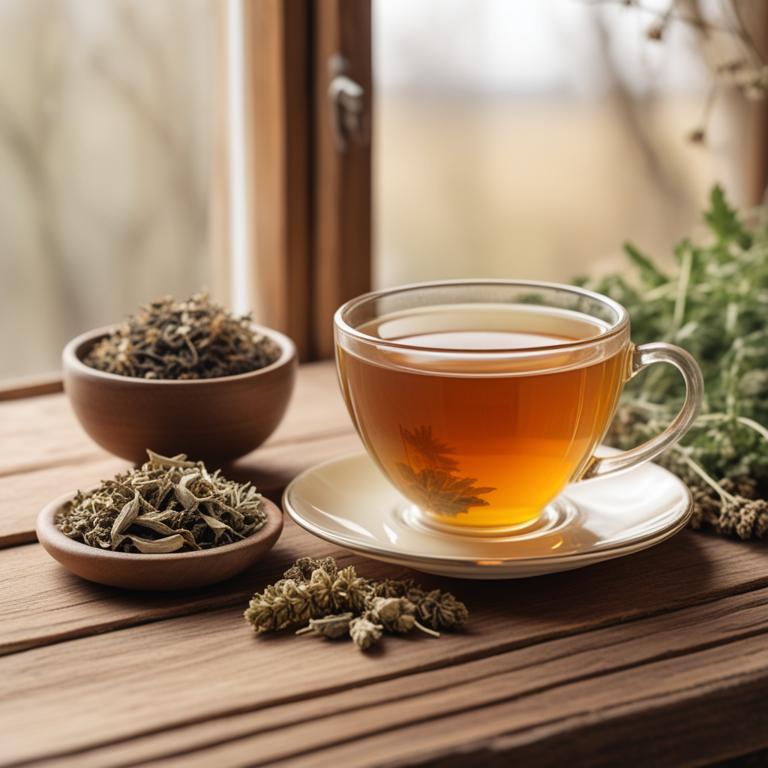
Glycyrrhiza glabra teas contains glycyrrhizin, a triterpenoid saponin that gives licorice root its anti-inflammatory properties.
These properties help to reduce swelling and irritation in the upper abdominal area, which can cause pain. Glycyrrhizin also has a soothing effect on the stomach lining, protecting it from acid and digestive enzymes that can cause irritation. The flavonoids and phenolic acids present in the tea, such as luteolin and ferulic acid, also have anti-inflammatory and antioxidant properties that can help to reduce pain and inflammation in the upper abdomen.
By reducing inflammation and soothing the stomach lining, Glycyrrhiza glabra teas can help to alleviate upper abdominal pain.
- Gather ingredients: 1 cup of dried Glycyrrhiza glabra root, 1 cup of water, and a tea strainer.
- Measure 2 tablespoons of dried Glycyrrhiza glabra root into a tea infuser or a piece of cheesecloth.
- Heat 1 cup of water in a pot and bring it to a boil.
- Reduce heat, add the tea infuser or cheesecloth with the Glycyrrhiza glabra root, and let it steep for 5-7 minutes.
- Strain the tea and discard the root. Let the tea cool down before drinking it, up to 3 times a day as needed.
3. Curcuma longa
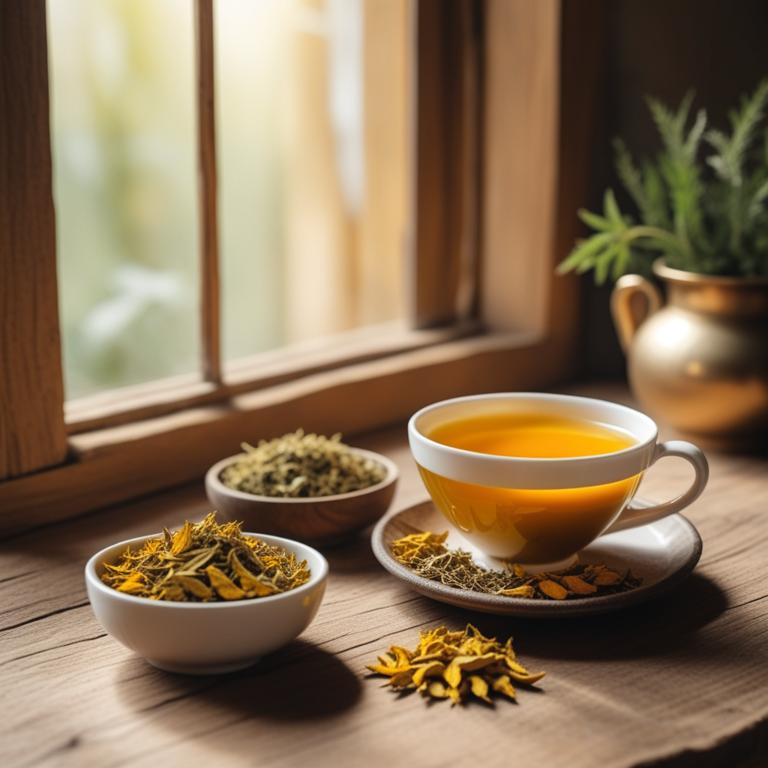
Curcuma longa teas contains curcumin, a bioactive constituent that has potent anti-inflammatory properties.
Curcumin blocks the production of prostaglandins, hormone-like substances that cause pain and inflammation in the upper abdomen. The antioxidant properties of curcumin also help to reduce oxidative stress, a known contributor to abdominal pain. Additionally, curcumin has a protective effect on the gut by reducing inflammation and promoting the growth of beneficial gut bacteria.
By reducing inflammation and promoting gut health, curcuma longa teas can help alleviate upper abdominal pain.
- Get 1 cup of boiling water
- Add 1/2 to 1 teaspoon of dried Curcuma longa root
- Let it steep for 5-7 minutes
- Strain the tea and discard the root
- Drink the tea 2-3 times a day as needed
4. Foeniculum vulgare
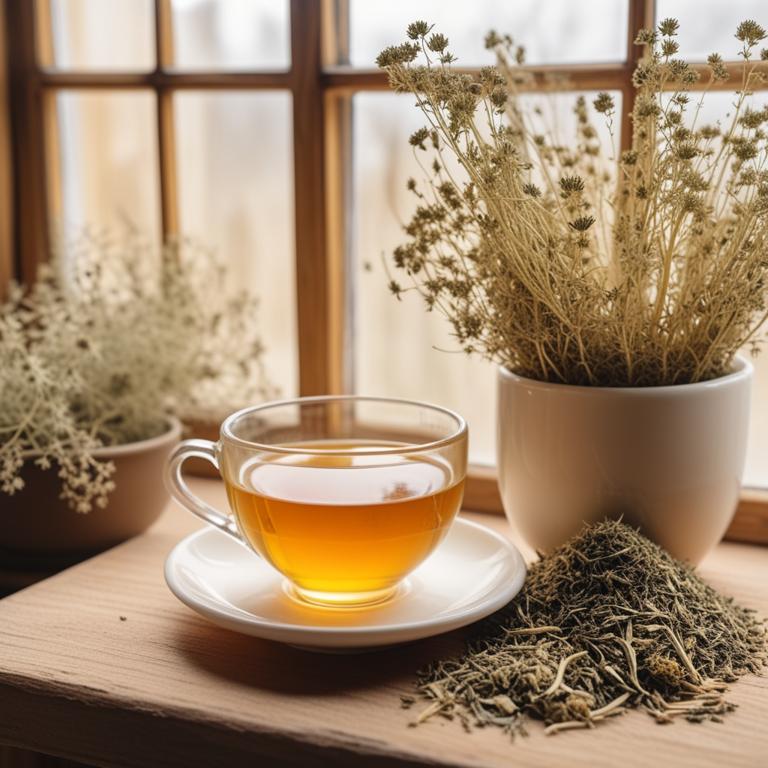
Foeniculum vulgare teas contains a compound called anethole, which is responsible for its therapeutic effects.
Anethole has anti-inflammatory and antispasmodic properties, which can help relax the muscles in the upper abdomen and reduce inflammation. The essential oil in Foeniculum vulgare, which is rich in limonene and fenchone, can also help alleviate digestive issues and ease cramps in the upper abdominal region. The antispasmodic properties of Foeniculum vulgare can also help to calm the digestive system and prevent spasms that may be contributing to the pain.
By reducing inflammation and calming the digestive system, Foeniculum vulgare teas may provide relief for people experiencing upper abdominal pain.
- Gather 1 teaspoon of dried Foeniculum vulgare (anise) seeds.
- Boil 1 cup of water in a pot.
- Add the dried anise seeds to the boiling water.
- Reduce heat and let it simmer for 5-7 minutes.
- Strain the tea and drink it as is, or add honey to taste.
5. Cinnamomum verum

Cinnamomum verum teas contains a compound called cinnamaldehyde, which has anti-inflammatory properties that help to reduce swelling in the digestive tract.
Cinnamaldehyde also has a stimulating effect on digestive enzymes, which helps to improve digestion and reduce bloating. The tea also contains a compound called linalool, which has a calming effect on the muscles in the digestive tract and helps to relax the stomach. Additionally, Cinnamomum verum teas contain a compound called eugenol, which has a protective effect on the stomach lining, helping to prevent stomach ulcers and irritation.
By reducing inflammation, improving digestion, and protecting the stomach lining, Cinnamomum verum teas can help to relieve upper abdominal pain.
- Gather 1 teaspoon of Cinnamomum verum bark and 1 cup of water.
- Boil the water in a pot and reduce heat to a simmer.
- Add the Cinnamomum verum bark to the water and let it steep for 5 minutes.
- Strain the mixture into a cup and discard the bark.
- Drink the tea warm or at room temperature to help relieve upper abdominal pain.
6. Mentha x piperita
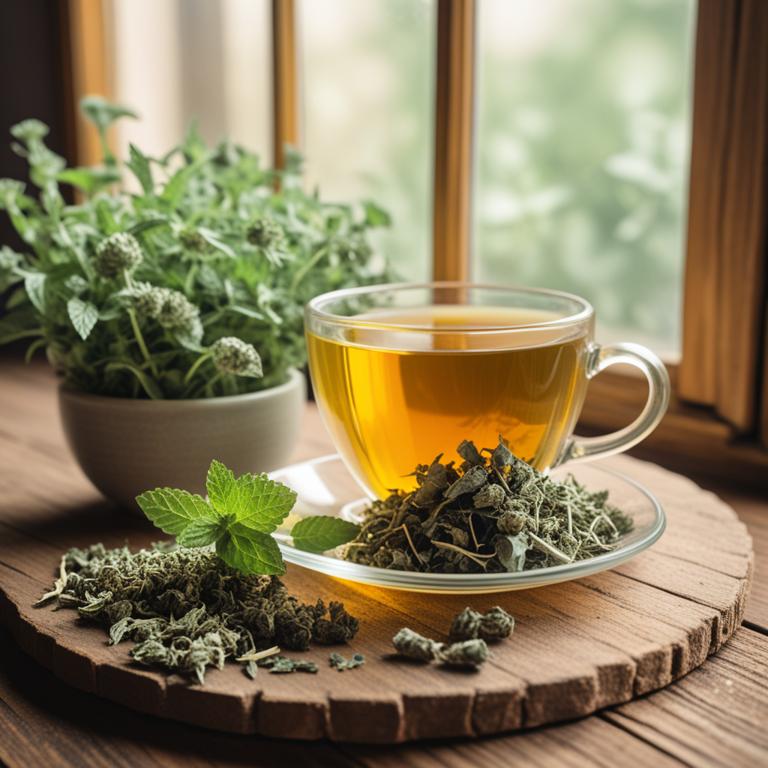
Mentha x piperita teas contains the bioactive constituents menthone, limonene, and beta-pinene, which have anti-inflammatory and digestive properties.
These compounds help to relax the muscles in the upper abdomen, reducing cramping and spasms that can cause pain. The menthol in Mentha x piperita teas also has a soothing effect on the digestive system, helping to reduce inflammation and ease discomfort. Additionally, the tea's carminative properties help to release trapped gas in the digestive system, further alleviating upper abdominal pain.
By combining these properties, Mentha x piperita teas can help to alleviate upper abdominal pain by reducing inflammation, relaxing muscles, and easing digestive discomfort.
- Gather 1 cup of fresh peppermint leaves (Mentha x piperita) or 1 teaspoon of dried peppermint leaves.
- Heat 1 cup of water in a pot until it boils.
- Add 1 tablespoon of honey (optional) and 1 cup of fresh peppermint leaves to the boiling water.
- Reduce heat and let it simmer for 5-7 minutes. Strain the tea and discard the leaves.
- Drink the tea while it's warm. Repeat as needed, but not more than 3 times a day.
7. Cinchona officinalis

Cinchona officinalis teas contains a group of alkaloids called quinoline, which includes compounds like quinine and quinidine.
These alkaloids have anti-inflammatory properties, which can help reduce swelling and ease pain in the upper abdominal area. The quinoline compounds in Cinchona officinalis also have a sedative effect, which can help calm digestive issues that may be contributing to the pain. Additionally, Cinchona officinalis teas contain aucubine and serpentine, which have antispasmodic properties that can help relax the muscles in the digestive tract and relieve cramps.
By combining these properties, Cinchona officinalis teas may provide relief from upper abdominal pain by reducing inflammation, calming digestive issues, and relaxing muscles.
- Gather 2 tablespoons of dried Cinchona officinalis bark, 1 cup of boiling water, and a strainer.
- Steep the dried bark in the boiling water for 5-7 minutes.
- Strain the mixture into a cup using the strainer.
- Add honey or lemon to taste, if desired.
- Drink the tea 2-3 times a day as needed for upper abdominal pain relief.
8. Ginkgo biloba

Ginkgo biloba teas contains flavonoids and terpenoids as its active constituents.
These compounds have anti-inflammatory properties, which can help to reduce swelling and pain in the upper abdominal area. Flavonoids, such as quercetin and kaempferol, have been shown to have antioxidant effects, which can help to protect the stomach lining from damage and inflammation. Terpenoids, including bilobalide, have been found to have anti-spasmodic properties, which can help to relax the muscles in the stomach and reduce pain.
By consuming Ginkgo biloba teas, individuals may experience relief from upper abdominal pain due to its anti-inflammatory, antioxidant, and anti-spasmodic properties.
- Gather 1 cup of boiling water and 1 teaspoon of dried Ginkgo biloba leaves.
- Measure 1 teaspoon of dried Ginkgo biloba leaves and place them in a tea infuser or a heat-resistant cup.
- Pour the boiling water over the Ginkgo biloba leaves and let it steep for 5-7 minutes.
- Strain the tea into a cup and discard the leaves. Add honey or lemon to taste if needed.
- Drink the tea 2-3 times a day to help alleviate upper abdominal pain.